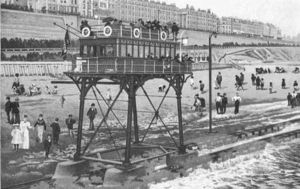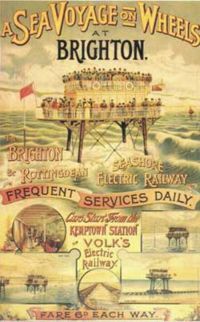Brighton and Rottingdean Seashore Electric Railway
The Brighton and Rottingdean Seashore Electric Railway was a unique railway in Brighton, UK that ran through the shallow waters of the English Channel between 1896 and 1901.
Magnus Volk, the owner, designer, and engineer, had already been successful with Volk's Electric Railway, a more conventional trolley which had then not been extended east of Paston Place. Facing unfavorable geography, Volk decided to construct a line through the surf from a pier at Paston Place to one at Rottingdean.
The railway itself consisted of two parallel 2ft 8½" gauge tracks, billed as 18ft gauge, the measurement between the outermost rails. The tracks were laid on concrete sleepers mortised into the bedrock. The single car used on the railway was a 45ft by 22ft pier-like building which stood on four 23ft long legs. The car weighed 45 tons. Propulsion was by electric motor. It was officially named Pioneer, but many called it Daddy Long-Legs. Due to regulations then in place, a qualified sea captain was on board at all times, and the car was provided with lifeboats and other safety measures.
Construction took two years from 1894 to 1896. The railway officially opened 28 November 1896, but was nearly destroyed by a storm the night of 4 December. Volk immediately set to rebuilding the railway including the Pioneer, which had been knocked on its side, and it reopened in July 1897.
The railway was popular, but faced difficulties. The car was slowed considerably at high tide, but Volk could never afford to improve the motors. In 1900, groynes built near the railway were found to have led to underwater scouring under the sleepers and the railway was closed for two months while this was repaired. Immediately afterward, the council decided to build a beach protection barrier, which unfortunately required Volk to divert his line around the barrier. Without monies to do so, Volk closed the railway. In 1901 the right-of-way was broken up for construction of the barrier. One further attempt was made to raise money for a conventional over-water viaduct along roughly the same route.
The track, car and other structures were sold for scrap, but some of the concrete sleepers can still be viewed at low tide. Eventually Volk's Electric Railway was extended onshore, covering a portion of the same distance; it remains in operation.
External links
- The Volks Electric Railway Association, with some information about 'Daddy Long Legs'
- Daddy Longlegs by John Roles, Brighton Museum
de:Brighton and Rottingdean Seashore Electric Railway
ru:Daddy Long Legs


